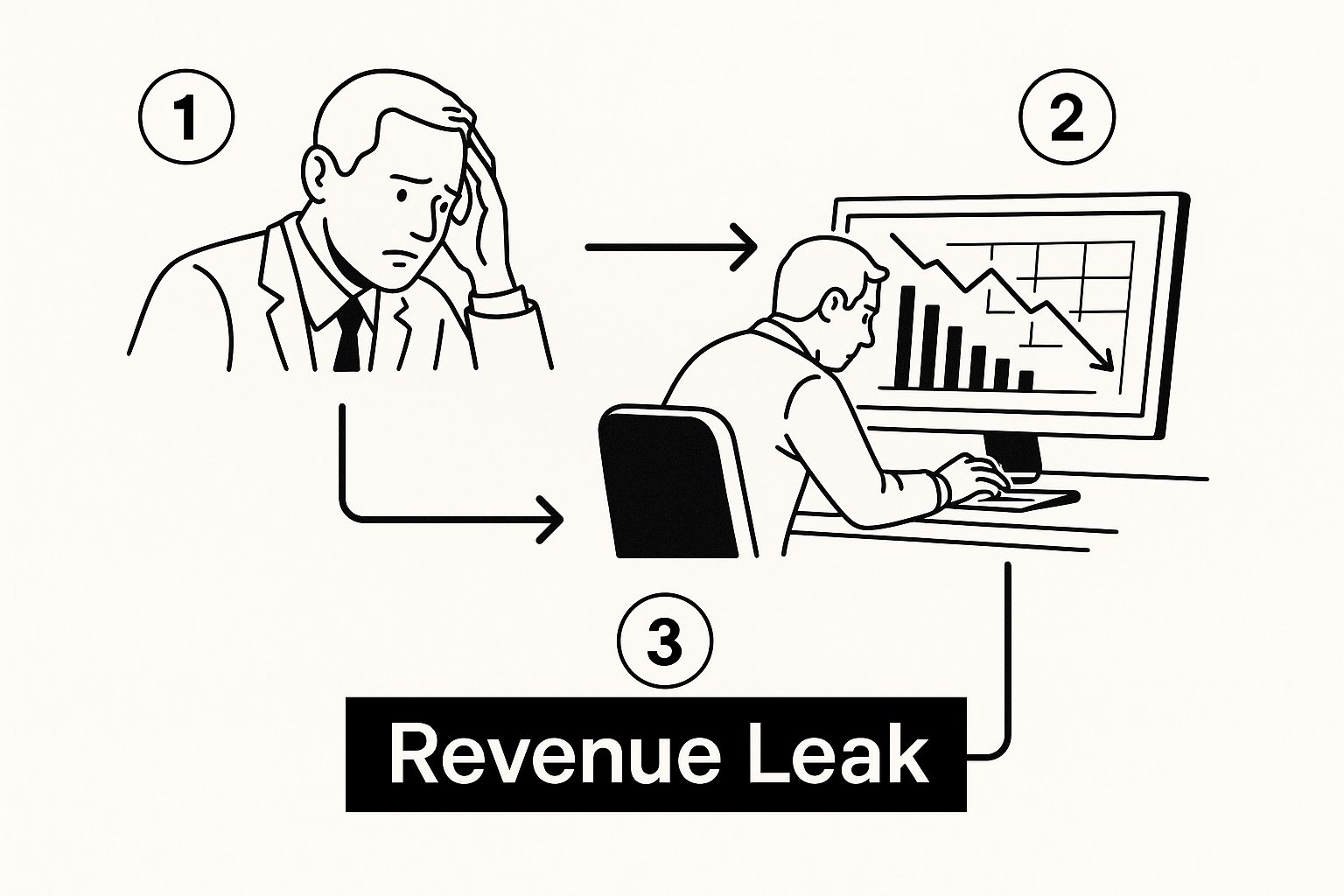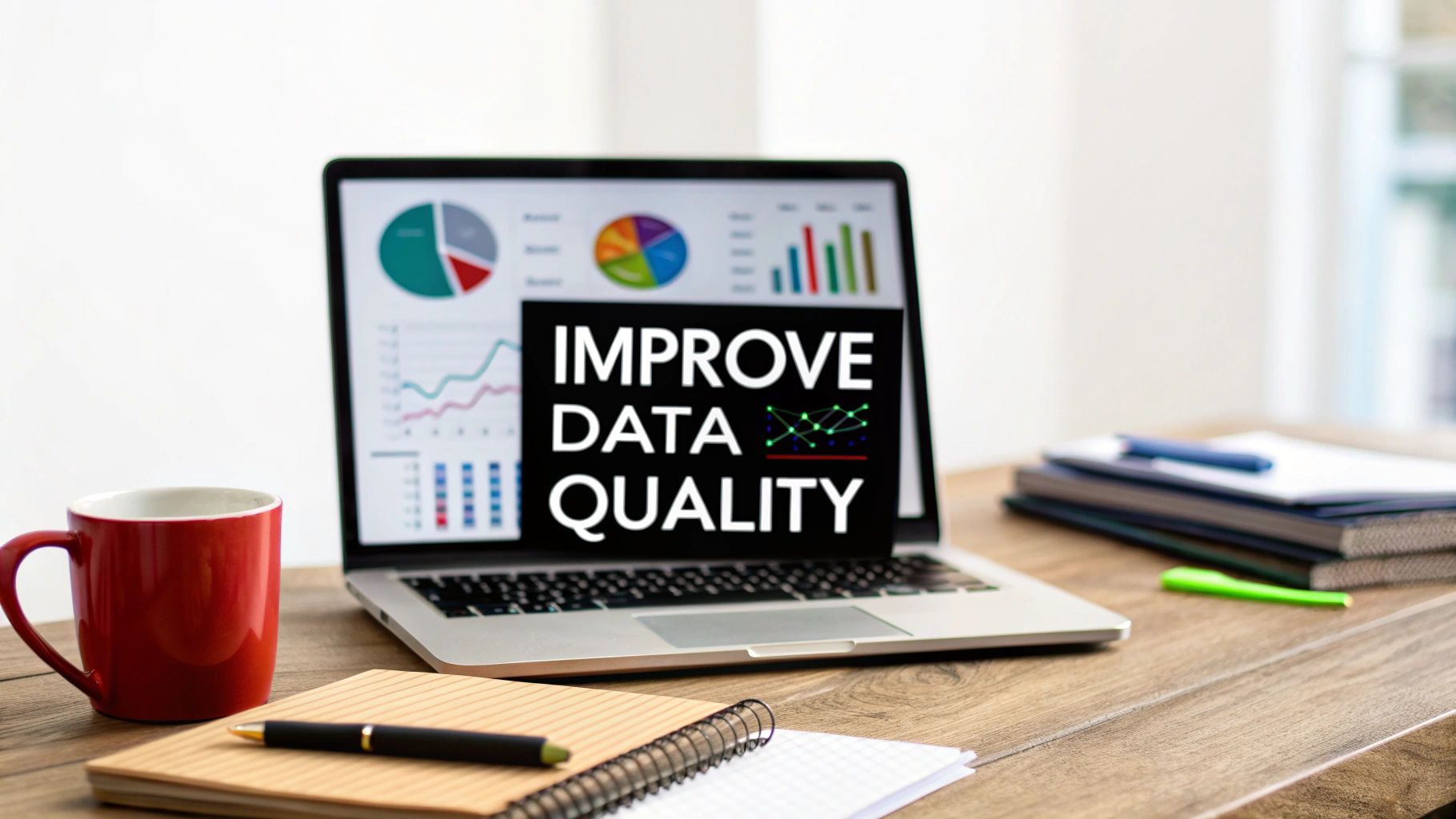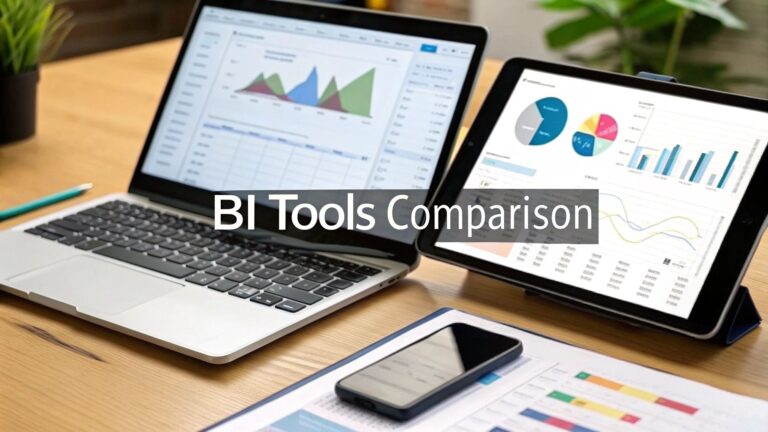A Guide on How to Improve Data Quality
To get data quality right, you need a unified system built on three core elements: smart governance, modern technology, and a data-aware culture. This isn't just an IT project. It means assigning clear ownership, using AI and automation to clean and validate information, and getting every single team member to understand their role in keeping data clean. It’s how you turn data from a simple asset into your most reliable strategic advantage.
We'll dive deep into the specific strategies, but first, let's frame the conversation around the foundational pillars that support any successful data quality initiative.
Four Pillars of Data Quality Improvement
This table gives a high-level overview of the core strategies that form the foundation for improving data quality, which we will explore in detail throughout this guide.
| Pillar | Objective | Key Actions |
|---|---|---|
| Data Governance | Establish clear ownership and rules for data management. | Define data stewards, create data dictionaries, and document data lineage. |
| Technology & Automation | Use modern tools to clean, validate, and enrich data. | Implement AI-powered validation, de-duplication software, and automated enrichment workflows. |
| Process Integration | Embed data quality checks directly into business workflows. | Add validation rules at the point of data entry and automate cross-system data syncs. |
| Culture & Training | Foster a company-wide commitment to data integrity. | Conduct regular training, create data quality dashboards, and tie data accuracy to team KPIs. |
Each of these pillars is crucial. Skipping one is like trying to build a house on an unstable foundation—it’s only a matter of time before things start to crumble.
The Hidden Costs of Inaccurate Data
Bad data is more than just an IT headache; it's a silent killer of revenue and a major roadblock to growth. Most B2B and SaaS companies seriously underestimate the financial damage caused by seemingly small mistakes—a misspelled name, an outdated lead status, a wrong job title. These "minor" flaws create massive ripple effects that sabotage operations and drain profits.
This infographic shows just how easily small data errors can snowball, leading to a significant revenue leak that silently damages a company's bottom line.

As you can see, flawed data isn't a single event. It’s a chain reaction that torpedoes everything from marketing efficiency to sales conversions and customer trust.
The scale of this problem is huge. The global cost of poor data quality is a staggering $3.1 trillion per year in the United States alone. On average, companies lose between 20–30% of their revenue because of bad data. That translates to an average loss of $12.9 million annually for each company, a devastating financial hit. You can dig deeper into these financial impacts on data quality management.
Misinformed Strategies from Flawed Insights
When your data is unreliable, every strategic decision you make is built on quicksand. Leadership teams depend on dashboards to guide everything from market expansion to product development. But if that data is wrong, you're essentially flying blind.
Imagine a SaaS company analyzing user engagement to decide which features to build next. If their data can't distinguish active users from inactive ones because of an integration bug, they might pour resources into a feature for a user segment that barely exists. The result? Wasted engineering time, missed opportunities, and a product that doesn't solve real problems.
"Bad data is worse than no data at all because it leads you to believe you're on the right path when you're actually headed for a cliff. It gives you a false sense of security while actively undermining your strategy."
This isn't just a hypothetical. It’s a classic pitfall that stops businesses from ever finding true product-market fit.
Wasted Budgets and Damaged Relationships
Sales and marketing teams feel the pain of bad data most directly. Every dollar spent on a campaign targeting the wrong person or using incorrect information is a dollar down the drain.
- Ineffective Personalization: Think about launching a personalized email campaign where contacts get addressed by the wrong name or are offered a service they already have. Your engagement plummets, and your brand looks incompetent.
- Wasted Sales Efforts: When your sales team is working from a CRM full of duplicate leads and outdated contact info, they spend more time cleaning up messes than actually selling. One bad record can lead to hours of wasted calls and missed quotas.
- Eroded Customer Trust: Nothing sours a customer relationship faster than showing them you don’t know who they are. Inaccurate bills, bungled support tickets, and mixed-up communication preferences are a direct path to churn.
Here's a real-world example: A B2B tech company spends $50,000 on a targeted ad campaign using flawed firmographic data. The ads hit businesses in the wrong industry, resulting in zero qualified leads. That’s a total waste of budget—a direct, measurable loss caused by a simple failure to maintain data quality.
Ultimately, making data quality a business-wide priority is the first step toward plugging these leaks and building a more resilient, profitable company.
Building a Practical Data Governance Framework
Let's be honest, the term "data governance" can make you want to run for the hills. It brings to mind dusty binders, endless meetings, and charts no one understands. But in practice, a good governance framework is just about setting some clear, common-sense rules for your data. It's less about bureaucracy and more about answering simple questions like, "Who’s in charge of this?" and "What does a good record actually look like?"
Forget the abstract theories. We're talking about making your data trustworthy and useful for the people who need it every day—from the sales rep trying to update a CRM record to the CEO looking at a quarterly dashboard. It’s the bedrock of any serious attempt to clean up your data for good.
When you don't have clear rules and ownership, you get chaos. Sales and marketing start using different definitions for "lead," finance has one version of a customer's name, and support has another. A solid governance framework is your best defense against that kind of confusion.
Establish Clear Data Ownership and Stewardship
The first step is a big one: assign responsibility. The old saying, "When everyone owns it, no one owns it," is painfully true for data. You need to anoint specific people or teams as data stewards for your most important data sets.
For a typical B2B or SaaS company, this is pretty straightforward:
- Sales Ops gets ownership of lead, contact, and opportunity data in the CRM.
- Marketing Ops is the steward for all campaign and prospect engagement data.
- The Product Team takes charge of user behavior and in-app activity metrics.
- The Finance Team owns all things billing and subscription-related.
These people aren't just gatekeepers; they’re champions for good data. It’s their job to make sure the information in their domain is accurate, complete, and well-documented. They become the go-to experts when someone has a question or spots an issue.
A great data steward doesn't just protect the data; they make it useful. They're the ones who connect the dots between what the business needs and what the data can provide, whether that's for a new marketing campaign or a critical financial forecast.
This simple act of assigning ownership immediately solves the finger-pointing problem. If lead data is a mess, everyone knows Sales Ops is on point to investigate and fix it. No more confusion, no more excuses.
Define Your Core Data Quality Metrics
Once you know who’s responsible, you need to agree on what "good" looks like. This means setting clear, measurable standards for your data. Don't try to boil the ocean here. Start with a few core metrics that will give you the most bang for your buck.
Here are the essentials I always start with:
| Metric | What It Actually Measures | A Real-World Gut Check |
|---|---|---|
| Accuracy | Is the data just plain correct? | Does the phone number in the CRM actually ring the right person? |
| Completeness | Are all the critical fields filled out? | Does every new lead record have a name, email, and company? Always? |
| Timeliness | Is the data fresh enough to be useful? | When a customer pays, does their status flip from "trial" to "active" instantly? |
| Consistency | Does the data look the same everywhere? | Is "Acme Corporation" spelled the same way in your CRM, billing platform, and support tool? |
Defining these gives your team a shared language. Instead of a vague complaint like "the CRM is a disaster," someone can now say something concrete and actionable: "Over 30% of our new leads are missing a job title, and it’s tanking our completeness score." See the difference? Now you have a problem you can actually solve.
Start Small with a Crawl-Walk-Run Approach
Trust me on this: trying to roll out a company-wide governance plan all at once is a recipe for disaster. It's too big, too disruptive, and people will resist. The secret is to find one high-impact area, prove the value, and then expand. It's the classic "crawl-walk-run" strategy.
For most B2B companies, the absolute best place to start is your customer data. It’s the lifeblood of the business and touches marketing, sales, and success.
- Crawl: Pick one thing. Just one. Focus only on the customer profiles in your CRM. Assign a data steward, define the quality metrics for those specific records, and create a dead-simple data dictionary for key fields like "Lead Status" or "Customer Tier." That’s it.
- Walk: Once you've shown real improvement there, you’ve earned the right to expand. Start pulling in related data sets, like marketing engagement history or support tickets associated with those customers.
- Run: Now that you have momentum, you can start applying these same principles to other parts of the business, like product usage data or financial records.
This phased approach builds trust and shows tangible results fast. It’s a lot easier to get buy-in from leadership and other departments when you can point to a small-scale success story. That’s how you start winning the war on bad data without overwhelming your entire team.
Using AI and Automation for Data Cleansing

While a solid governance framework sets the rules, it's technology that actually enforces them at scale. Let’s be honest, manually scrubbing thousands of records is a soul-crushing, and ultimately impossible, task. This is where you bring in your most powerful ally to improve data quality: AI and automation.
Forget the abstract buzzwords. For our purposes, AI is a practical engine that spots patterns humans would miss, and automation is the workhorse that executes the cleanup tirelessly and instantly. It’s the difference between bailing out a leaky boat with a bucket and installing a pump that keeps you afloat 24/7.
Automating Data Profiling and Standardization
Before you can fix your data, you have to understand exactly what’s broken. This is where AI-powered tools really shine at data profiling. They scan entire databases in minutes, not days, to give you a full health report—identifying null values, weird formatting, and outliers.
Imagine your CRM has a "Country" field. An AI profiler can instantly reveal that you have entries for "USA," "U.S.A.," "United States," and "America." Finding and fixing those manually would be a nightmare. An automated tool not only flags them but can apply a predefined rule to standardize every single one to "United States," making your data consistent overnight.
This initial profiling step is critical. It gives you a clear, data-driven baseline of your quality issues, allowing you to prioritize the cleanup efforts that will actually have the biggest impact.
Once you have that diagnostic, automation takes over the standardization. This just means applying a consistent format to specific data types, which is essential for any reliable analytics or segmentation.
- Phone Numbers: Automatically reformatting entries like
(555) 123-4567and555.123.4567into a single, unified format like+15551234567. - Job Titles: Grouping similar titles—think "VP of Sales," "Sales Vice President," and "VP, Sales"—under one standardized category.
- Addresses: Parsing street names, cities, and zip codes into separate, correct fields to stop deliverability issues in their tracks.
These small, automated fixes compound over time, making your data infinitely more useful without you having to lift a finger.
Leveraging Machine Learning for Advanced Cleanup
Standardization is a great start, but the real magic of AI comes from its ability to solve more nuanced problems. I'm talking about the stuff that keeps you up at night, like duplicate detection and data enrichment.
Traditional de-duping relies on exact matches. If two records don't have the exact same name and email, they’re considered unique. This old-school approach misses a shocking number of duplicates.
For instance, a traditional system would completely fail to connect these two records:
- Record A: Jon Smith,
jon.smith@acmecorp.com - Record B: Jonathan Smith,
jsmith@acme-corp.com
Machine learning algorithms, on the other hand, use fuzzy matching to spot these non-exact duplicates. They analyze multiple fields, phonetic similarities, and common patterns to calculate a probability score that two records are the same person. This is how you catch the subtle duplicates that plague most CRMs.
Beyond de-duping, AI tools can also automate data enrichment. Instead of your sales reps manually digging through LinkedIn for a prospect's company size or industry, an enrichment tool can pull this information from third-party sources and append it directly to the record. Your data isn't just clean—it's complete and far more valuable. For growing businesses, learning how to automate data entry with smart tools like these is a total game-changer.
Choosing the Right Technology Stack
To make all this happen, you need the right tools. The market is full of options, but they generally fall into two buckets, both designed to help improve data quality.
| Tool Category | Primary Function | Best For |
|---|---|---|
| Data Quality (DQ) Platforms | Profiling, cleansing, standardizing, and monitoring data within existing systems. | Teams needing to clean up data in specific apps like a CRM or marketing automation platform. |
| Master Data Management (MDM) Solutions | Creating a single, unified "golden record" for each entity (e.g., customer, product) across all systems. | Larger organizations struggling with data consistency across multiple, disconnected databases. |
When you're evaluating platforms, look for a few non-negotiable features. You absolutely need robust data profiling, flexible standardization rules, and AI-powered fuzzy matching. Another must-have is real-time validation. This checks data at the point of entry, preventing bad data from ever getting into your system in the first place. Trust me, it’s far more effective than constantly cleaning up messes after the fact.
Integrating Data Quality into Daily Workflows

Think of a one-time data cleanup project like frantically cleaning your house right before a party. It looks fantastic for a day, but without daily habits, the mess creeps back in. The only way to achieve lasting data quality is to stop treating it like a special project and start weaving it into the very fabric of your team's day-to-day work.
This isn't just about cleaning up mistakes; it's a fundamental shift from reactive fire-fighting to proactive, continuous improvement. It’s about making data hygiene a natural, almost unconscious, part of everyone’s job—from the sales rep entering a new lead to the marketing manager launching a campaign.
And the need for this shift has never been more urgent. Recent research shows that data quality is now the number one challenge for 64% of organizations, a massive jump from 50% just a year ago. This is compounded by a serious crisis of confidence, with 67% of business leaders admitting they don’t fully trust their own data for making decisions. You can discover more insights about these data integrity challenges.
Making Data Quality a Shared Responsibility
For years, data quality got stuck with the "IT problem" label or was seen as just another ops task. That approach is a recipe for failure. Why? Because the people who create and use the data every single day are the ones with the most power to keep it clean. The solution is to adopt a DataOps mindset.
DataOps treats your data like a product, where everyone shares responsibility for its health and reliability. It means sales, marketing, success, and finance are all on the same team, working together to maintain a single source of truth.
When a sales rep understands that a complete and accurate CRM record directly impacts marketing's ability to run a successful campaign, they stop seeing data entry as a chore and start seeing it as a crucial part of the revenue engine.
This cultural shift is the first, most critical step. It reframes data quality from a technical chore to a shared business goal that everyone has a stake in.
Embed Validation at the Point of Entry
The best place to stop bad data is at the front door. Instead of constantly running cleanup scripts to fix errors that have already polluted your system, you can prevent them from getting in at all. The trick is to build validation rules directly into your tools, especially your CRM.
Here are a few practical examples you can implement right away:
- Required Fields: Make essential fields like "Company Name," "Email," and "Lead Source" mandatory before a new record can be saved. No more mystery contacts.
- Format Masks: Enforce a consistent format for phone numbers or postal codes. This ensures every entry follows the same pattern, making the data uniform and usable.
- Dropdown Menus: Swap out open text fields for things like "Industry" or "Country" with predefined picklists. This simple change eliminates typos and frustrating variations like "USA," "U.S.A.," and "United States."
These rules act as your first line of defense, making it easy for your team to do the right thing and hard to do the wrong one. Building these checks into your systems is a foundational principle of effective data management, which you can dive into deeper in our guide to data integration best practices.
Automate Alerts and Gamify Performance
Even with the best preventative measures, some bad data will inevitably slip through the cracks. The key is to catch it—fast. Setting up automated alerts is an incredibly powerful way to flag anomalies before they can cause any real damage.
For instance, you could easily build a workflow that pings a specific Slack channel whenever:
- A new lead is created with a free email domain like
@gmail.com. - An opportunity's value is changed by more than 50%.
- A record is flagged by your system as a potential duplicate.
These real-time alerts transform data monitoring from a passive, once-a-quarter task into an active, immediate process.
Want to take it a step further? Gamify it. You can build data quality right into your team's KPIs by creating a simple "Data Quality Score" for each rep based on the completeness and accuracy of their records. Put it on a public dashboard to spark some friendly competition. When people can see how their individual contributions affect the company's data health, they become far more invested in getting it right every time.
How to Measure Your Data Quality ROI
Improving your data quality isn't just a backend chore; it’s a real business investment. And like any other investment, you need to justify it. That means proving its worth to leadership by connecting your cleanup efforts directly to the bottom line.
The key is to shift the conversation away from abstract ideas like "clean data" and toward concrete metrics that matter to the business. When you can show exactly how better data cuts costs, drives revenue, and makes everyone more efficient, you start speaking a language the C-suite understands.
Connecting Technical KPIs to Business Outcomes
First things first, you have to track the technical side of data quality. These metrics are the vital signs of your database's health. But on their own, they don't mean much to anyone outside of your team. The real trick is tying these numbers directly to the company's financial performance.
Here are a few technical KPIs I always start with, along with how to frame them as business drivers:
-
Duplicate Record Rate: This is simply the percentage of redundant contacts or accounts cluttering up your system. Don't just report that you have "15% duplicates." Translate that into business impact. Explain that it means your sales team is wasting 15% of its time calling the same people, and marketing is blowing budget targeting the same prospect multiple times.
-
Data Completeness Score: This one tracks how many of your critical data fields are actually filled out. A low score isn't just an ops headache. It's the reason your lead scoring is off, your personalization efforts fall flat, and your sales team is flying blind when trying to qualify leads.
-
Time to Resolve Data Issues: How long does it actually take to fix an error once you find it? A faster resolution time means less damage downstream and a more agile operation. Think of it as a direct measure of your team’s efficiency and the strength of your data governance.
The goal here is to tell a story with your data. A 20% drop in duplicate records isn’t just a cleaner CRM; it’s a 20% efficiency boost for the sales team. That's time they can put back into activities that actually bring in money. Now that's a story that gets people to listen.
Calculating the Financial Impact
Once you've made that connection between technical stats and business operations, you can start putting real dollar signs on it. Calculating the ROI of data quality isn't about getting a perfectly precise number; it's about building a solid business case with reasonable, defensible estimates. If you want to go deeper on this, check out our full guide on how to calculate return on investment.
I recommend focusing your calculations on the three areas where good data delivers the most punch:
| Impact Area | How to Measure It | Example Calculation |
|---|---|---|
| Reduced Operational Costs | Figure out the time saved on manual data fixing and wasted marketing or sales efforts. | 10 sales reps save 2 hours/week each by not chasing bad leads. At a loaded cost of $50/hour, that's a direct saving of $1,000 a week, or $52,000 a year. |
| Improved Campaign Performance | Connect data accuracy to better engagement and higher conversion rates. | Cleaning your email list boosts deliverability by 5%. This results in 500 more qualified leads per quarter, potentially adding an extra $75,000 to the pipeline. |
| Increased Sales Productivity | Measure how better data shortens the sales cycle and improves win rates. | With complete, accurate data, reps cut down on research time. This leads to a 10% increase in calls and a 2% lift in their win rate. |
When you present these kinds of figures, your data quality project stops looking like a "cost center" and starts looking like a "profit center." It's no longer just an expense—it's a strategic move with a clear financial payoff. This is how you secure the budget you need and get lasting support for your work.
Tackling Your Top Data Quality Questions
Putting a new data quality strategy into motion always brings up a ton of practical questions. It’s one thing to get the theory, but it's another thing entirely to make it work when you're in the trenches.
This is your go-to guide for those "what do I do now?" moments. I'll walk you through some of the most common questions I hear from teams just like yours.
Where Do I Even Begin with a Data Quality Initiative?
This is the big one, and my answer is always the same: start small. You absolutely cannot boil the ocean. If you try to fix every data problem at once, you'll get bogged down and lose momentum before you even start.
The smart move is to pick one area where a little improvement will make a huge, visible impact.
For nearly every B2B and SaaS company I've worked with, that starting point is customer data inside your CRM. It's the heart of your entire revenue operation, touching everything from marketing campaigns to sales outreach and customer support. Clean up your CRM data first, and you'll get tangible wins you can show off to get buy-in for bigger projects.
How Can I Get My Team to Actually Care About Data Quality?
Let's be honest: no one gets excited about administrative busywork. The key isn't to force compliance but to show everyone what's in it for them. You have to connect the dots between clean data and their own success.
Here's how to make it happen:
- Make it tangible. Don't just lecture about the importance of "good data." Show a sales rep how a complete and accurate contact record leads directly to a faster deal. Show a marketer how a well-segmented list boosts their campaign engagement.
- Make it easy. People take the path of least resistance. Use automation to make the right way the easiest way. Set up validation rules, use dropdowns instead of free-text fields, and automatically enrich records.
- Make it a game. A little friendly competition never hurts. Create a simple "Data Health Score" and put it on a dashboard where everyone can see it. You'd be surprised how quickly people start working to improve their score.
What's a Data Quality Tool Going to Cost Me?
This is a huge range. You could be looking at a few hundred bucks a month for a simple add-on or tens of thousands for a full-blown Master Data Management (MDM) system. But honestly, that’s the wrong question.
The real question is: what is bad data costing you right now?
Think about it this way: research shows poor data quality costs the average company a staggering $12.9 million every year. Suddenly, a tool that costs $10,000 a year but saves your team hundreds of wasted hours and stops you from burning marketing budget doesn't seem so expensive, does it?
Always frame this as an investment, not a cost. Do the math on the hours you'll save and the revenue you'll gain from better targeting. When you build the business case around ROI, the right tool more than pays for itself.
Ready to stop fighting bad data and start building efficient, scalable workflows? MakeAutomation specializes in implementing the AI and automation frameworks that turn data chaos into a competitive advantage. Book a consultation today and see how we can help you reclaim time and accelerate your growth.







